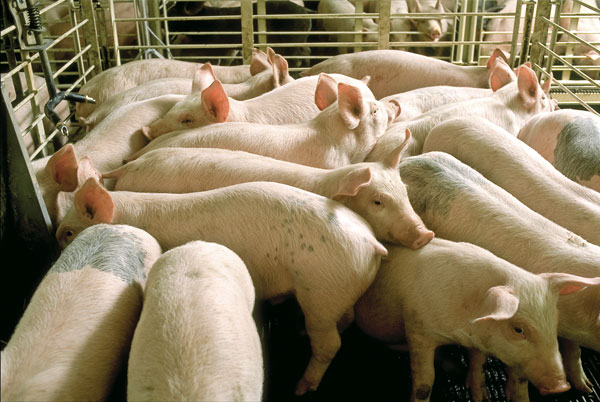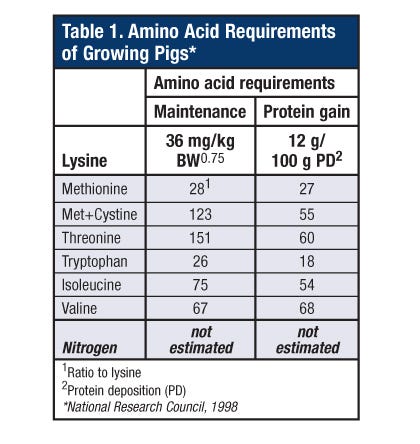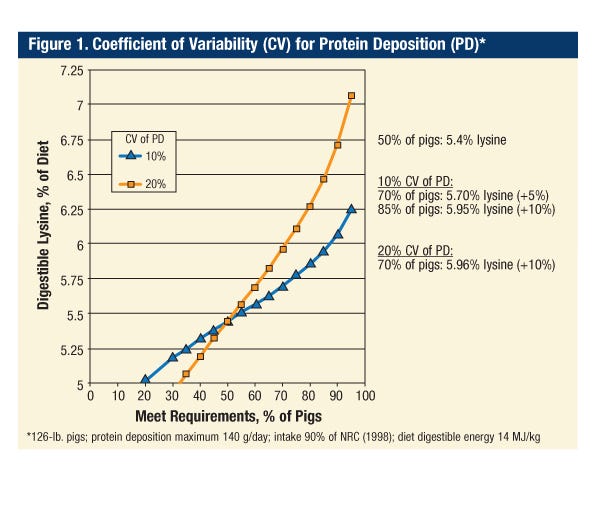The convergence of dietary amino acids and protein depsition in the pig's body is a biochemical and physiological process that is influenced by a range of factors, such as the pigs' genotype, stage of growth and environmental factors such as diet fiber levels, thermal and physical environment and disease status.
February 1, 2012

There is a movement afoot in the North American swine industry to update amino acid requirements in swine diets and move more readily toward a cost-benefit analysis when developing optimum dietary amino acid levels. Kees de Lange, swine nutritionist at the University of Guelph in Ontario, carried that banner to the Conference on Feed Efficiency staged in Omaha in early November.
“Clearly, there is a difference between feeding pigs to requirements for maximal performance vs. feeding optimum amino acid levels to maximize profits. A key determinant of amino acid requirements is whole-body protein deposition, which is very closely associated with lean tissue growth; these two measures are essentially interchangeable,” he reinforces.
A 10% increase in protein deposition represents a 5-6% improvement in feed efficiency. But the benefits to production reach beyond feed conversion because as protein deposition increases, fat deposition decreases and carcass value improves.
The convergence of dietary amino acids and protein deposition in the pig’s body is a biochemical and physiological process that is influenced by a range of factors, such as the pigs’ genotype, stage of growth and environmental factors such as diet fiber levels, thermal and physical environment and disease status.
Optimum Amino Acid Levels
To get a handle on optimum dietary amino acid levels, it is important to understand the amino acid needs of various body functions. Additionally, the units used to express dietary amino acid needs should be consistent with ingredient evaluation, that is, the bioavailability and digestibility of amino acids in feed ingredients.
“Traditionally, in North America, we formulate diets for digestibility, but when we talk about heat-treated feed ingredients such as distiller’s dried grains with soluble (DDGS), we have to realize that some of those digestible amino acids are not necessarily available for metabolism by the pig, and we have to go a step further. That’s quite an important aspect of feed evaluation,” says de Lange.
For heat-treated ingredients, we have to look beyond standardized or “true” amino acid digestibility and also consider the chemical availability of amino acids, especially lysine. “We generally talk about requirements for body functions, but we are increasingly becoming aware that amino acids also have physiological functions and can influence gene expression and endocrinology. We have come to appreciate that specific amino acids will have some effects beyond being building blocks of protein,” he explains.
This deeper understanding brings into question the concept of optimum amino acid balances and the compatibility of balancing diets based on the concept of the first limiting amino acid.
To advance the discussion, de Lange turns to the National Research Council (NRC) amino acid requirements of growing pigs established in 1998 (Table 1). The 13-year-old guidelines benchmark amino acid requirements for maintenance that are driven by lysine requirements — 36 mg/kilogram of metabolic body weight — while using a fixed balance among amino acids to estimate maintenance requirements for all other amino acids.

“When we talk about amino acid requirements for production, we’re really talking about requirements for protein deposition,” he continues. The NRC (1998) recommendation is 12 grams of lysine/100 grams of protein deposition, with again fixed ratios to estimate requirements for other amino acids.
“Essentially, what the NRC did was dilute the relative requirements for maintenance and protein deposition, which provided a variable amino acid profile for various stages of production and levels of performance,” he says. “What the NRC did not do is provide estimates for nitrogen requirements. I would put forth that after we consider requirements for key amino acids such as lysine, threonine, tryptophan, methionine, plus cysteine, isoleucine and valine, and before the other essential amino acids, nitrogen requirements become limiting. We need to better understand nitrogen requirements, especially as we move to increased usage of crystalline amino acids in pigs’ diets.”
Key Limitations
The main limitation of the NRC (1998) approach is that constant amino acid requirements per unit of body protein deposition were assumed. We now know that amino acid requirements for protein deposition vary with pig genotype, body weight, dietary fiber levels, health status and between-animal variability, so the NRC approach was a somewhat simplistic interpretation,” de Lange continues.
Based on the pig’s biology, the contributors to amino acid requirements for protein deposition in the pigs include:
• Rate of protein deposition and its amino acid composition, and
• The inefficiencies of utilizing available amino acid intake over the maintenance requirements for protein deposition. Amino acid catabolism (breakdown) is the main contributor to those inefficiencies and results in urinary nitrogen excretion. Through research conducted during the last decade, we have learned that amino acid catabolism is influenced by animal and environmental factors. In addition, energy intake can limit protein deposition, in which case amino acids are used as a source of energy rather than building blocks for
protein.
Summarizing, de Lange says the biology of nutrient utilization should serve as a guide to setting amino acid requirements, taking into account their “true” digestibility and chemical availability. Estimates should account for animal variability and nutritional history and be based on the responses of groups of pigs fed different levels of amino acids. Ultimately, a cost-benefit analysis will be needed, he says.
Dollars and Cents
“When considering between-animal variability in performance levels, we have to decide what proportion of pigs we want to feed to requirements and over what time periods. That’s really where the dollars and cents come in,” de Lange notes.
“The coefficient of variability (CV) — the variability of protein deposition for all of the pigs in the barn — is usually 10% or more and is closely related to variability of daily live weight gain,” he says. “In the cost-benefit analysis, estimate the variability and meet the requirements of 70% or more of the pigs.”
In Figure 1, the lysine requirement is on the “y” axis and the relative proportion of pigs that you want to meet the requirement of is on the “x” axis.

“In this example, if you want to meet the lysine requirement of 50% of the pigs, 5.44% lysine is required. Of course, variability in this case is unimportant because half of the pigs are above and half below that level. If the CV of protein deposition is 10% and you want to meet the lysine requirement of 70% of the pigs, 5.70% lysine is needed — 5% higher than the previous example. If you want to meet the lysine requirement of 85% of pigs, lysine level would be 10% higher still — 5.95% lysine,” he continues.
“If the CV of protein deposition is higher, say 20%, and you want to meet the lysine requirement of 70% of the pigs, lysine level would be 5.96%. This is some of the thinking that we need to go through as we start to quantify variability in performance levels because it will have a large impact on the amino acid levels fed and, therefore, the cost-benefit analysis.”
NRC Updates Ahead
Updates to the NRC amino acid requirements, scheduled for release in 2012, will be based on “the most comprehensive review of amino acid requirements studies conducted around the world in the last 15-20 years,” de Lange assures. “The group has been very careful to review the available literature and recalculate the diets just to make sure that what is in the publication is consistent with what you would get in the diets.
“For individual studies, amino acid requirements were recalculated. We then applied a simple trick using ‘the magic triangle’ to the biology of growth in the pig. It is the relationship of energy intake over maintenance, body weight gain, and protein deposition, plus body lipid deposition. To estimate protein deposition from body weight gain based on energy partitioning, we adjusted protein deposition until partitioning of energy intake over maintenance between protein deposition, plus lipid deposition is consistent with observed body weight gain,” he explains. “If we know two of the three components, we can predict the third.” Using this approach, observed amino acid requirements can be related to rates of body protein deposition and body weight gain and can be extrapolated to different groups of pigs with varying feed intake and growth performance levels.
Amino Acid Recap
“Whole-body protein deposition is closely associated with feed efficiency,” de Lange summarizes. “In the last couple of years, substantial progress has been made in understanding amino acid utilization for protein deposition, which has allowed swine nutritionists to estimate amino acid requirements for growing pigs of different ages and genotypes. Young pigs have a tremendous potential for protein gain, so we may want to focus more on the younger pigs,” he continues.
“The next challenge would be to move away from the ‘requirements’ and really look at the pigs’ response to varying amino acid intake levels, the principle of diminishing marginal efficiencies, taking nutritional history into account, and therefore allowing for more effective cost-benefit analysis when establishing the optimum dietary amino acid levels.”
You May Also Like



